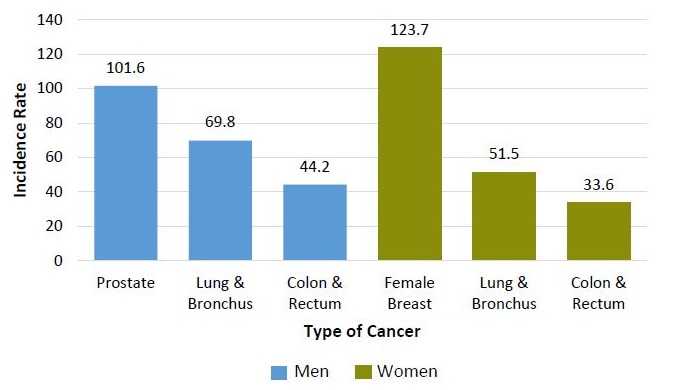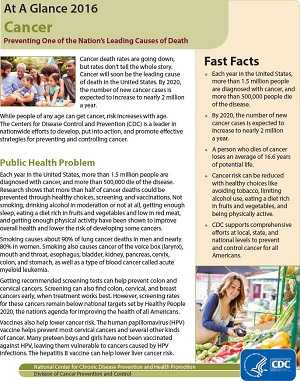Cancer
Preventing One of the Nation’s Leading Causes of Death
At A Glance 2016
Cancer death rates are going down, but rates don’t tell the whole story. Cancer will soon be the leading cause of death in the United States. By 2020, the number of new cancer cases is expected to increase to nearly 2 million a year.
While people of any age can get cancer, risk increases with age. The Centers for Disease Control and Prevention (CDC) is a leader in nationwide efforts to develop, put into action, and promote effective strategies for preventing and controlling cancer.
Public Health Problem
Each year in the United States, more than 1.5 million people are diagnosed with cancer, and more than 500,000 die of the disease. Research shows that more than half of cancer deaths could be prevented through healthy choices, screening, and vaccinations. Not smoking, drinking alcohol in moderation or not at all, getting enough sleep, eating a diet rich in fruits and vegetables and low in red meat, and getting enough physical activity have been shown to improve overall health and lower the risk of developing some cancers.
Smoking causes about 90% of lung cancer deaths in men and nearly 80% in women. Smoking also causes cancer of the voice box (larynx), mouth and throat, esophagus, bladder, kidney, pancreas, cervix, colon, and stomach, as well as a type of blood cancer called acute myeloid leukemia.
Getting recommended screening tests can help prevent colon and cervical cancers. Screening can also find colon, cervical, and breast cancers early, when treatment works best. However, screening rates for these cancers remain below national targets set by Healthy People 2020, the nation’s agenda for improving the health of all Americans.
Vaccines also help lower cancer risk. The human papillomavirus (HPV) vaccine helps prevent most cervical cancers and several other kinds of cancer. Many preteen boys and girls have not been vaccinated against HPV, leaving them vulnerable to cancers caused by HPV infections. The hepatitis B vaccine can help lower liver cancer risk.
CDC’s Response
The National Center for Chronic Disease Prevention and Health Promotion (NCCDPHP) works in four key areas or domains: epidemiology and surveillance, environmental approaches, health care system interventions, and community programs linked to clinical services. This comprehensive approach supports healthy choices and behaviors, makes healthier options more available, and helps Americans better manage their health.
With $335 million in FY 2016 funding, CDC’s Division of Cancer Prevention and Control works with partners—such as public health agencies, other federal agencies, academia, and community organizations—to support these efforts by working in all four of NCCDPHP’s domains.
Epidemiology and Surveillance
The National Program of Cancer Registries (NPCR) supports central cancer registries in 45 states, the District of Columbia (DC), Puerto Rico, and the US Pacific Island Jurisdictions. These registries, which represent 96% of all new cases, collect and analyze data about US cancer cases and deaths. The data can be used to:
- Define and monitor cancer incidence, prevalence, and deaths at local, state, and national levels.
- Investigate patterns of cancer treatment.
- Identify subpopulations at higher risk.
- Evaluate the effectiveness of public health prevention efforts.
In 2014, seven NPCR cancer registries were funded to capture data on pediatric and young adult cases within 30 days of a diagnosis, which is faster than the traditional reporting time of up to 2 years. To shorten reporting time, registries increased electronic reporting from multiple sources, including out-of-state children’s hospitals.
NPCR data are also combined with data from the National Cancer Institute and CDC’s National Vital Statistics System to create the United States Cancer Statistics: Incidence and Mortality Web-based Report. National, regional, and state data from this report are used to conduct epidemiologic studies on cancer incidence, deaths, and trends. Results are published in reports such as the Annual Report to the Nation on the Status of Cancer.
Top Three Cancers in the United States, by Sex, 2013
Note: Rates are per 100,000 people and age-adjusted to the 2000 US standard population.
Source: United States Cancer Statistics: 1999-2013 Incidence and Mortality Web-based Report.
Environmental Approaches
Comprehensive Cancer Prevention and Control
CDC’s National Comprehensive Cancer Control Program (NCCCP) funds all 50 states, DC, 7 tribes or tribal organizations, and 7 US territories to set up cancer coalitions, assess the burden of cancer, define priorities, and develop action plans. Comprehensive cancer control is a process through which key partners form coalitions and pool their resources to prevent and control cancer in their jurisdictions.
CDC also provides coalitions with evidence about what works to prevent and control cancer. Grantees use this evidence to choose strategies that can help increase the use of recommended cancer screenings, increase access to quality cancer care, and improve the quality of life for cancer survivors.
Campaigns to Promote Awareness, Education, and Screening
In 2015, CDC launched the Bring Your Brave campaign to provide information about breast cancer to women younger than 45. The campaign tells real stories about prevention, risk, family history, and survivorship as a way to inspire young women to learn their risk of breast cancer and talk with their health care provider about how to reduce it. CDC has created tools and materials to support these women and their families.
Another CDC campaign, Inside Knowledge: Get the Facts About Gynecologic Cancer, raises awareness among women and health care providers about the five main types of gynecologic cancers: cervical, ovarian, uterine, vaginal, and vulvar. While these cancers are often discussed as a group, each is unique and has different signs, symptoms, risk factors, and prevention strategies. Since the campaign began, its public service announcements have had 6.2 billion audience impressions. The website has had 5.6 million visits, making it by far the most popular CDC cancer website.
The Screen for Life: National Colorectal Cancer Action Campaign was launched in 1999 to raise awareness of and increase screening for colon (or colorectal) cancer. This ongoing campaign is based on extensive research among men and women aged 50 or older, who are at highest risk. Screen for Life partners with health departments in all 50 states, DC, and tribes and tribal organizations; grantees from CDC’s Colorectal Cancer Control Program (CRCCP); and the National Colorectal Cancer Research Alliance of the Entertainment Industry Foundation. Educational and media materials are available in English and Spanish. From March to May 2016, social media posts and display ads yielded 38 million audience impressions.
Health Care System Interventions
CRCCP, which was created in 2009, began a new award in 2014 that funds 23 state health departments, 6 universities, and 1 tribal organization to increase colon cancer screening among men and women aged 50 or older. Since 2014, grantees have established partnerships with 118 health systems that serve more than 624,000 patients aged 50 to 75. Six grantees receive additional money to pay for screenings for eligible low-income adults who are uninsured or underinsured.
CDC also offers two free, online continuing education courses for doctors and nurses:
- Screening for Colorectal Cancer: Optimizing Quality. This activity provides guidance and tools for clinicians on the best ways to use colon cancer screening to ensure that patients receive the most benefit. Versions are available for primary care providers and for clinicians who perform colonoscopies.
- Gynecologic Cancer Curriculum. CDC’s Inside Knowledge campaign developed this curriculum to increase health care provider knowledge about cervical, ovarian, uterine, vaginal, and vulvar cancers.
Fast Facts
- Each year in the United States, more than 1.5 million people are diagnosed with cancer, and more than 500,000 people die of the disease.
- By 2020, the number of new cancer cases is expected to increase to nearly 2 million a year.
- A person who dies of cancer loses an average of 16.6 years of potential life.
- Cancer risk can be reduced with healthy choices like avoiding tobacco, limiting alcohol use, eating a diet rich in fruits and vegetables, and being physically active.
- CDC supports comprehensive efforts at local, state, and national levels to prevent and control cancer for all Americans.

CDC Works to Improve Quality
of Life for Cancer Survivors
Cancer survivors often face physical, emotional, psychosocial, spiritual, and financial challenges as a result of their diagnosis and treatment. CDC is working to address survivorship and quality of life issues that affect cancer survivors, such as coordination of care, patient-provider communication, health promotion, support services, and fertility preservation.
These efforts include research and collaboration with public, nonprofit, and private organizations.

“Cancer is a devastating disease. We are encouraged that cancer incidence and death rates are declining and that more people are living longer after a cancer diagnosis. This trend means that public health must adapt to ensure that survivors receive the care and resources they need.”
Lisa Richardson, MD, MPH Director of CDC’s Division of Cancer Prevention and Control
Skin Cancer Prevention
at the Community Level
Skin cancer is the most common cancer in the United States. It is caused by exposure to ultraviolet (UV) light from sources such as the sun and indoor tanning devices. The numbers of both new cases and deaths from melanoma, the most deadly type of skin cancer, are increasing.
In July 2014, the Office of the US Surgeon General, in collaboration with CDC, released The Surgeon General’s Call to Action to Prevent Skin Cancer. The Call to Action described strategies that work and called on all community sectors to address skin cancer as a major public health priority.
Indoor tanning can expose users to excessive levels of UV light, which are harmful and easily avoided. This excessive UV exposure greatly increases a person’s risk of getting some types of skin cancer, including melanoma. Many people begin indoor tanning during adolescence. CDC developed Policies and Practices for Cancer Prevention: Reducing Indoor Tanning Among Minors to lead public health efforts to protect the future health of today’s youth.

Community Programs Linked to Clinical Services
CDC’s National Breast and Cervical Cancer Early Detection Program (NBCCEDP) funds programs in all 50 states, DC, 5 US territories, and 11 tribes or tribal organizations to provide low-income, uninsured, and underserved women access to timely breast and cervical cancer screening and diagnostic services. In FY 2015, NBCCEDP provided breast and cervical cancer screening to 451,209 low-income, uninsured, and underinsured women, diagnosing 5,312 women with breast cancer and 3,220 women with invasive cervical cancer or high-grade premalignant lesions.
NBCCEDP also supports public health activities to set up effective programs and increase screening rates for all women. Examples of these activities include outreach, education, case management, quality assurance, and program evaluation. Since it began in 1991, NBCCEDP has provided more than 12 million breast and cervical cancer screening exams for nearly 5 million women.
Future Directions
To further its goal of ensuring that people are healthy at every stage of life, CDC will continue to:
- Promote system and policy changes that support cancer prevention, not just treatment.
- Bring together traditional and nontraditional partners to design comprehensive approaches to cancer control.
- Lead the nation’s efforts to translate, put into action, and evaluate evidence-based interventions and policies.
- Be the primary resource for high-quality cancer data that help public health professionals understand and address the cancer burden.
- Improve health outcomes for cancer survivors through a unified survivorship agenda.
- Page last reviewed: October 17, 2016
- Page last updated: October 17, 2016
- Content source:



 ShareCompartir
ShareCompartir

